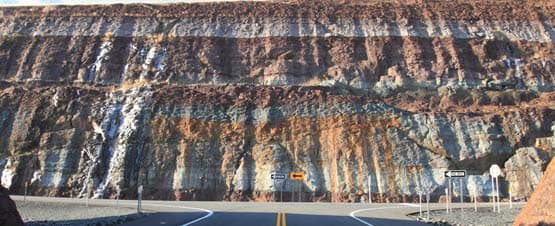History and Anatomy of a Blast
Our Commitment, Our Customers’ Peace of Mind
History of Rock Blasting: From Art to Science
In the old days, the blaster would puff on his cigar until it was red hot, touch it to the fuse and "run like hell."
Before the rackbar machine, (a plunger that generates an electric current), that's how blasters set off their charges. Drilling wasn't any more sophisticated: Hand chisels were employed to make the holes in which the charges were packed.
As for explosives, black powder, first used for blasting in Hungary in 1627, gave way to dynamite in the mid 1800s when Alfred Nobel of Sweden saturated porous earth with nitroglycerin. The resulting solid lacked the volatility of "nitro" but could still be detonated by a blasting cap. In later years, sugar cane and wood pulp replaced earth in his formula.
Today, technology has turned what was once an art into a science. Maine Drilling & Blasting is on the cutting edge.
These techniques permit the blaster to program a series of small explosions, thousandths of a second apart, reducing risk and increasing control.
Also known as bulk, packaged in "sausage" casings or pumped into the boreholes, provide the blaster with powerful precision tools.
This and test-blast practices have replaced trial-and-error, providing a controlled environment. Of course, any blast design is only as good as the data. For the most reliable data, the designers at Maine Drilling & Blasting can utilize a few high-tech tools: 3-D images of rock to be blasted developed in Auto-Cad, laser profiles of the rock surface developed with the assistance of drones, and profiles of the 3-dimensional actual location of the drilled holes developed with Boretracking systems.
A driller may have an idea what the borehole looks like beneath his feet, but with his senses alone, he can't be absolutely sure. Did the drill "wander?" Does the angle match the desired plan? If not, safety can be compromised. Boretrak provides the answers. A stainless steel probe containing gravity sensors and attached to carbon fiber rods is lowered into the hole. Data, regarding pitch, roll and depth is fed into the laptop and produces a three-dimensional view of the actual hole, taking guesswork out of the process. And when a free face is in question relative to bore hole wander, laser profiling is interfaced.
Some rock faces are not easy to read for a blaster deciding where to drill and how to load explosives. One misread situation can mean fly-rock and the kind of noise that makes for unhappy neighbors. Another kind may result in poor breakage and high vibration. In these situations, Maine Drilling & Blasting relies on the Laser Profiler, which bounces pulsed laser beams off the rock face, providing a precise three-dimensional "read" for use with the loading process.
Anatomy of a (Maine Drilling & Blasting) Blast
A controlled commercial blast is over in far less time than it takes to read this sentence. Yet the technical planning and preparation can take hours, sometimes days. The elements of this procedure are important to Maine Drilling & Blasting.
As a subcontractor, the blaster follows specifications set by the contractor, developer or government agency. The blaster also must adhere to the most restrictive of federal, state or local laws concerning the amount of explosives allowed and the magnitude of the resulting blast.

- Pre-Blast Preparation
- Designing a Blast
- The Blast
- The rock blasting superintendent evaluates the nature of the rock that needs to be removed and the general scope of the job.
- The safety specialist performs a pre-blast survey, inspecting and recording the homes, businesses, utilities and other structures in the area local to the blast site.
- As part of a community awareness program, the safety specialist distributes informational leaflets and discusses the possible effects of the blast on neighboring homes and businesses.
- The safety specialist and the rock blasting superintendent share their information and the blaster tailors the plan to create the least disruption while assuring safety.
- On a more complex job, a computer program may be tapped to help the blaster design the blast and customize the plan. In any case, a test blast is set off and monitored. The resulting data, measured by seismic and other monitoring equipment, is analyzed and integrated into the blast plan.
To ensure safety while still fragmenting the rock to the specification, the blasting superintendent has several choices to make and variables to manipulate. They include:
- The appropriate size of the blasts.
- The number of holes to be drilled, the depths and diameters of the holes, the pattern of the holes and the spacing between them.
- The sequence and pattern of multiple explosions. He determines the number of small explosions, thousandths of a second apart, that comprise a single blast. Designing the sequence adds to the amount of control the blaster has.
- The amount of explosive material needed and how much of it to load into each hole.
- Rock blasting crews set the blasting caps, load the holes with explosives, stem the holes with crushed stone, and connect each hole within the shot.
- Sometimes, to prevent rocks from flying, the blaster may cover the site with mats. A typical mat is made of recycled tires tightly compressed with steel cable. A 12-foot by 12-foot mat weighs about 6,000 pounds.
- Up until the time of the blast the shot area is secured.
- The site is evacuated and traffic, if any, is stopped.
- A horn is sounded three times to mark "Five Minutes Until Detonation."
- The horn is sounded twice to announce the one-minute mark.
- A blaster initiates the blast.
- The blasting crew inspects the site to make sure that all the explosives have been properly detonated.
- The horn is sounded once to signal "All Clear"